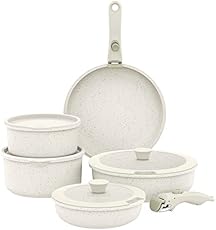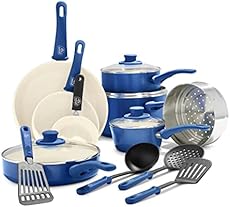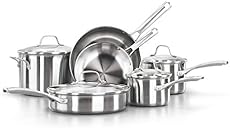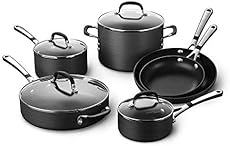Blog
Stainless Steel VS Non-stick Cookware

In our daily lives, we promptly reach out to whatever cookware are available in our cupboard for cooking. While shopping, often times, we are blissfully ignorant about the material and quality of the cookware that are handed down to us.
A little prior knowledge to choosing the right type of frying pans and pots for preparing specific food items can really make a significant difference in the taste and smell of the food along with our cooking experience.
Do you require cash to purchase new cookware? This issue has a solution thanks to PaydayDaze.
Shop Related Products
There is a common dilemma while choosing between an uncoated regular stainless steel and a non-stick cookware. To make life easier, below we have presented some insightful information highlighting the pros and cons between stainless steel and non-stick cookware to guide you through the process of choosing the right type of cookware for both professional and recreational purposes.
Stainless Steel Cookware

Stainless steel is a centerpiece of kitchen cookware that can be used for almost any type of job and has been a constant choice of professionals. While considering a stainless-steel cookware, the quality of the steel, its weight and price of the items are the key components to look at.
Stainless steel cookware are made of a combination of metals which includes carbon, iron, chromium, copper and a little mixture of few other metals. The chromium alloy is what gives the traditional glistening look to this beautiful cookware.
Advantages
Stainless steel cookware is made up of multiple layers of steel which provides the items its firmness and stability to last for years. There is no such harmful element as Perfluorooctanoic Acid (PFOA) and Polytetrafluoroethylene (PTFE) present in stainless steel as compared to non-stick cookware. So, there is no risk of any chemical reaction in high temperatures to diminish the nutrition value of the food or make it toxic.
In contrast to non-stick cookware, stainless steel is noteworthy for its high durability since it can withstand high temperatures. Often times stainless steel cookware come with steel handles and can be entered into the oven safely. The metals used to make the cookware are a source of great heat conductors, as a result the heat distribution is great throughout which leads to an even cooking of the meal without any hot spots.
Furthermore, some stainless-steel pans are lighter compared to non-stick, which makes it much more convenient to handle. In contrast to non-stick cookware, stainless steel is a beautiful piece of multipurpose kitchen cookware which is perfect for browning, braising and searing meats and other food items without any difficulty.
It also happens to be one of the most preferred cookware for water boiling, stewing, making soups and gravies, caramelizing onions and a lot of other tasks. This stainless-steel cookware are good to go for a long time even with a very low maintenance. It does not have to be pampered with all the seasoning to prevent the coat peeling off or to avoid rusting. The price ranges of these cookware vary from a low end to a high end but these are usually quite reasonable in comparison to other products with the same performance.
Disadvantages
Even though stainless-steel cookware is a great cooking tool serving almost all purposes, it has several drawbacks as well. Stainless steel is not a very good choice for gentle cooking or to heat an item that requires mild temperature.
It is best suited for rough and tough cooking schemes under high temperatures which eventually leads to a discoloration of the cookware. In addition, since stainless steel has an uncoated surface it cannot prevent food items from sticking to the pan. As a result, more oil, butter or lard is necessary for making the surface smooth. This makes the cleanup process quite difficult and tricky.
Non-stick Cookware

A non-stick cookware is a surface engineered kitchen tool made of Teflon that prevents food from sticking to the surface of the pan. Health-conscious individuals often apt for non-stick pans over stainless steel while cooking.
Advantages
Non-stick cookware requires a very minimum amount of oil or butter while cooking a meal compared to uncoated stainless-steel cookware. Thus, making it a means of healthier cooking. Furthermore, non-stick cookware is comparatively easier to use and wash since the slick coated surface prevents food from sticking to the pan.
This, certainly facilitates the washing process afterwards saving us a lot of time and energy. Another great advantage of using a non-stick pan is, it is resistant to acidic reactions such as wines, tomatoes, lemons etc.
whereas stainless steel can possibly react. Non-stick pans are greatly useful for cooking food items that requires mild temperatures and are commonly known to stick to the pan such as making egg omelets, pancakes etc. Another important feature of non-stick cookware is, it does not require a pre-heating process prior to adding ingredients. Usually, non-stick cookware are less expensive compared to stainless steel cookware
Disadvantages
Alongside the advantages of using non-stick cookware, there are quite a few potential risks of using such type of materials that needs to be addressed. The chemicals used for making the helpful shiny smooth surface as non-stick coatings can potentially have some environmental impacts according to a number of environmentalists and consumer organizations.
Some harmful chemicals used in the coating process includes PTFE which is also known as Teflon. Another chemical used for non-stick coating surface that is greatly subjected to health concerns is PFOA.
The Environmental Protection Agency has taken necessary initiatives to stop the production of PFOA. The exposure of non-stick cookware to very hot temperatures can release harmful chemicals into the air. While using a non-stick pan, try avoiding the use of metal forks or sharp spoons as this can leave scratch and remove the coating from the surface.
Conclusion
Even though there is a lot to consider while selecting your regular cooking pan, it is mostly a matter of convenience and preference. Be it stainless steel or non-stick cookware both serves its own purposes based on the type of food you wish to cook. So, when purchasing kitchen cookware, try selecting the items that best suits your cooking methods. However, having a clear understanding of the varieties can make your task a lot easier.













Comments